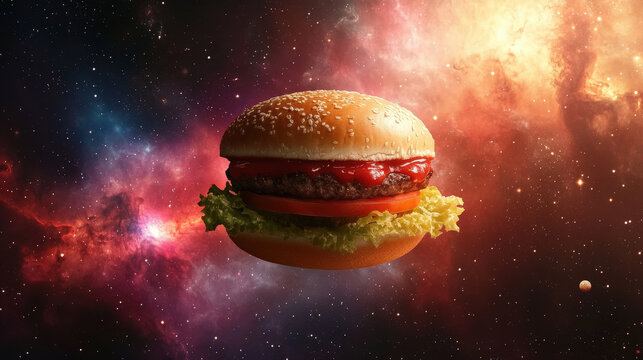No matter our occupation, nationality, or political stance, we can all agree that the idea of taking that big, good-for-nothing rock freeloading off of our airspace down a notch is something we’ve all been itching to do since we first set our eyes on it. And what better way to fulfill this deep-rooted desire than by obliterating the moon in the most eloquently devised method known to mankind? What I am, of course, alluding to is the classic military strategy of impact with a cheeseburger at egregiously high speeds (IWACAEHS), first developed by Russian scientist Aleksandr Petranovich at a Soviet experimental missile base after careful observation of a food fight between comrades in the ration allotment center. But while destroying Earth’s largest permanent satellite with a masterpiece of American culinary artifice may, at first glance, seem simple, careful thought will reveal some intricacies that may have escaped our first consideration: If by destroy we mean to completely and (semi) indefinitely disassemble, we will need to overcome the gravitational binding energy of the moon, which is about 1.24*10^29 Joules. This is a lot of Joules. This is, in fact, around 124000000000000000000000000000 Joules, which is probably more than the average person would have at their disposal. This means that, say, a Big Mac would need to travel at 1.02*10^15 meters per second or 2,281,740,000,000,000 miles per hour, which is nearly as fast as the freshmen run to the lunch line after class ends.
While black holes are no doubt what first comes to mind when we consider accelerating silly things, all energy extraction routes lead to somewhat inevitable problems. Using the Penrose process, energy can be extracted from a black hole by dropping an object into the area surrounding a rotating black hole’s event horizon, which, via its local pull on the spatiotemporal fabric, drags objects around it faster than can be physically resisted. This is an effect of both general and special relativity and has several fascinating parallels with magnetic induction, but is probably a terrible idea. The closest black hole is over 450 parsecs away, and given that we know almost nothing concerning its spin or electromagnetic field due to its lack of an accretion disc it would be terribly unfortunate to travel all that way just to be met with a highly suboptimal body for energy extraction. Besides, even under perfect conditions, spin only energy extraction can result in only up to 20% of mass/energy of the accelerated object as a yield, or, in this case, about 4314024857936725 Joules, or a little less than 30 trillion laps worth of energy. (Note: Due to patriotism, all calculations involving burger mass will be carried out in pounds, resulting in unit conversions that could make a researcher using SI units have an aneurysm.) Highly magnetized black holes could further help, but the requisite velocity would still require multiple events to reach. One could potentially build an autonomous spacecraft encasing the cheeseburger set on a course to bounce between two black hole systems, but that would take way too long. Oh well.
What’s next? Well… we sure like complaining about how many nuclear weapons all these world governments have. Why not reach IWACAEHS and remove some existential threat while we’re at it? And besides, building, say, an equatorial nuclear railgun would probably require the collaboration of many nations, fostering global interconnectedness and ushering in a new age of international peace. More importantly, the moon would be destroyed. We could set up a series of extremely powerful magnetic fields in a torus around Earth and funnel nuclear blast energy towards accelerating what would very quickly turn from a cheeseburger into a diffuse section of plasma around the planet until we release it at the moon. Using somewhat limited nuclear arms data, the total output of all of the planet’s nuclear weapons can be estimated at around 8505000000000000000 Joules, which is… not even close to enough. However, if we supplement this by devoting around 10% of our total energy consumption to storage for acceleration, given an annual 2% energy consumption growth rate, it would only take about 767 years to be able to reach speeds requisite for IWACAEHS (ignoring magnetic field maintainment energy costs, which would probably be quite high). If people don’t like a global 10% energy production tax for the next seven and a half centuries we could, alternatively, choose to cover either the entirety of Connecticut or Bexar County three times over with solar panels, which would passively offset the energy stored. 278 Kashiwazaki-Kariwa nuclear plants would also do the trick.
That sounds like a lot of work, though. A slightly lazier option would be to build a Dyson Sphere around the sun and wait for a while, but that’s also a lot of work and is pretty uninteresting. What we could do is place an (immortal, indestructible, adamantine) Big Mac in orbit around the nearest star capable of causing a supernova (Betelgeuse) and wait for it to do so. After only a handful of ten thousand years the burger could simply surf out on the wave of ejected plasma and exotic particles towards the unsuspecting moon, taking advantage of the truly ludicrous energy output of a stellar collapse of that scale.
While some of these propositions may seem idealistic, believe me, the goal of IWACAEHS can be reached, but only if action is taken now. To truly make a difference on a planetary scale we will all need to pitch in to help, whether that involves designing spacecraft or taste-testing varieties of ammunition. Just as Gandhi once said, be the change you wish to see in the world.

